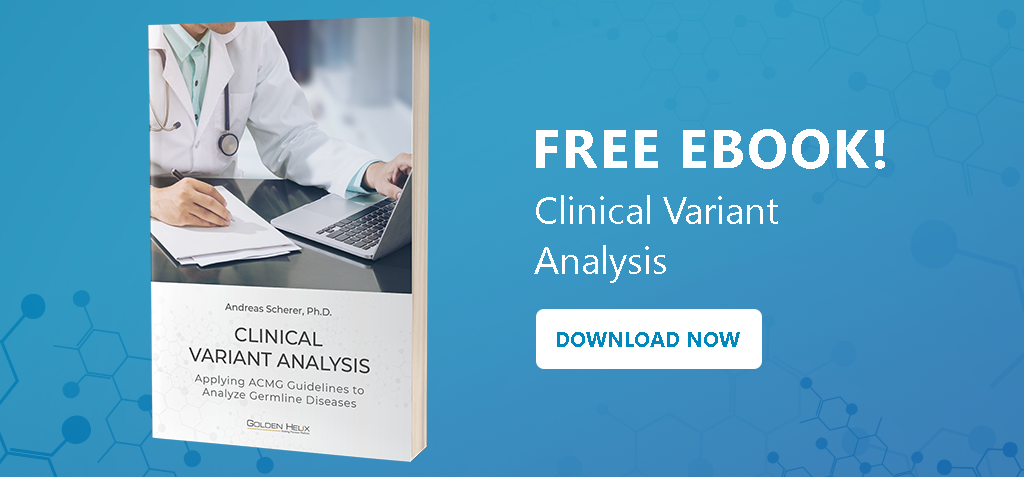In our recent webcast announcing the upcoming release of VarSeq VSClinical and the implementation of the ACMG guidelines for NGS CNVs, we had a number of live questions we didn’t get a chance to cover at the end of the presentation. I will follow up on those questions in this blog post. But first, if you didn’t get a chance to join us for the live event, you can access our on-demand recording below!
It is always a challenge to cover something as new and complex as these guidelines for interpreting CNVs that came out this year in Genetics for Medicine: Technical standards for the interpretation and reporting of constitutional copy-number variants: a joint consensus recommendation of the American College of Medical Genetics and Genomics (ACMG) and the Clinical Genome Resource (ClinGen). The guidelines are outlined in the 5 pages in the middle of the paper account for “Table 3”. But just reading that table alone will not prepare you to start interpreting CNVs and selecting from the roughly 80 scoring criteria. The ClinGen group put together nine webinars that cover different parts of the guidelines as well as how to use common data sources like gnomAD SV and DGV. In addition, there are 25 examples that dive into different CNV types and describe the decision process in evaluating which criteria apply in each example
Thankfully, our team has been attending these webinars, testing against these examples, and doing follow-up calls with the generous folks at ClinGen to design, implement and test the VSClinical interface that will support scoring these guidelines plentiful automation support of criteria and annotations when possible.
In my webcast presentation, I broke down the guidelines into three components:
- Evaluate the CNV: Score the impact of the CNV on the gene and if it has been observed in population catalogs at high frequencies
- Evaluate the gene: Lookup whether the gene have established evidence of dosage sensitivity (in ClinGen) or evaluate literature or clinical cases that provide evidence of dosage sensitivity
- Evaluate the patient: Determine the inheritance of this CNV and whether the inheritance tracks the clinical presentation.
After covering these in more detail and providing a walk-through of the workflow for a single CNV, I also demonstrated the ability of our Word-template based reporting system to provide customizable clinical reports with evaluated CNVs, variants, and QC information about the genetics tests such as total coverage statistics and failed target regions.

Here are a few questions asked by attendees at the end of the presentation:
Can I bring in CNVs from my own VCF files into this interpretation?
Yes, we have added a CNV VCF importer into VarSeq that we have tested on the output of a number of other different tools. Imported CNVs get associated with samples and then in VSClinical, are available to be imported as “Project CNVs” for the current evaluated sample.
Can the reports be made to look like the ones we use already in our clinical lab?
Yes, our Word-based template system allows you to define reports with all the rich features supported by Word. Page numbers, custom headers and footers, image backgrounds, exact page sizes with precise margins, and of course, all the content from your evaluation and patient details. We will provide a couple of different example reports for common situations such as trio analysis and hereditary gene panel testing.
I saw there was a slider bar for adjusting the score given when selecting criteria. Why is that a modifiable parameter and how should that be used?
The guideline authors allow some criteria to be adjusted based on the expert judgment of the user of the guidelines. Some criteria may be downweighted if there is some uncertainty about the strength of the evidence, or it could be upweighted if there is the evidence is overwhelmingly stronger than expected. The software captures these details from the guidelines for you, allowing you to make adjustments to the score, but starting with the default score. Similarly, the bounds of the adjustments made are built-in, ensuring that your results are always compatible with the guidelines.
For the CNV caller algorithm, what are the criteria that should be used for the NGS sample set? Is normal control(s) required for each data set to normalize the copy number?
Generally, controls can be re-used from one dataset or “run” to another when using the VS-CNV algorithm. The only requirement is that the same sequencing and library prep is used, and it is recommended that samples are sequenced to roughly the same depth.
When developing the software, have you encounter CNVs specific in different origins of humans i.e., European origin, Asian or African origin?
Interesting question! CNVs are much rarer than small variants, and although there are regions of the genome that commonly receive similar CNVs, the CNVs evaluated in a clinical testing context are often private to the family and de Novo. Certainly, common CNVs are sometimes specific to human populations just like they can be for variants. In general, we don’t expect populations or ethnic groups to have different phenotypic outcomes with the same genetic mutations, so common variants from any population group can be still be used as evidence that a CNV is benign regardless of the ethnicity of the current patient.
We are so excited to be able to finally share this workflow with our community after months of development, along with a number of introductory packages we have made available for this release.